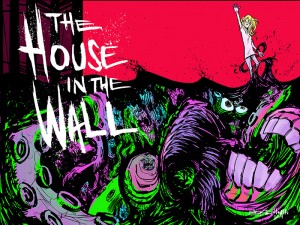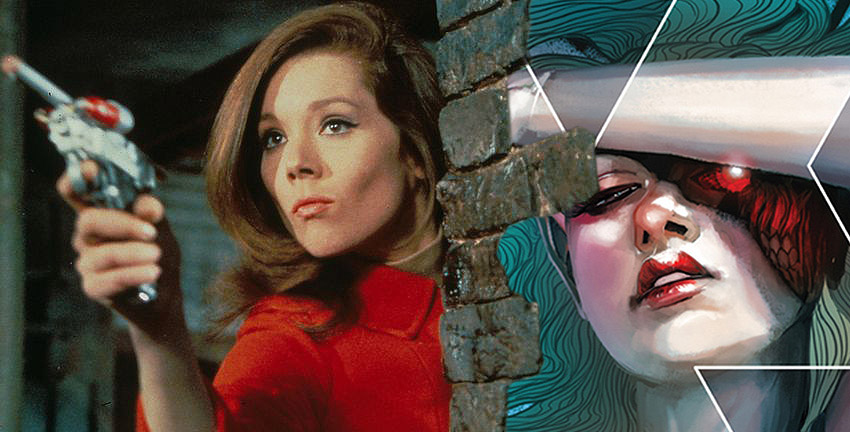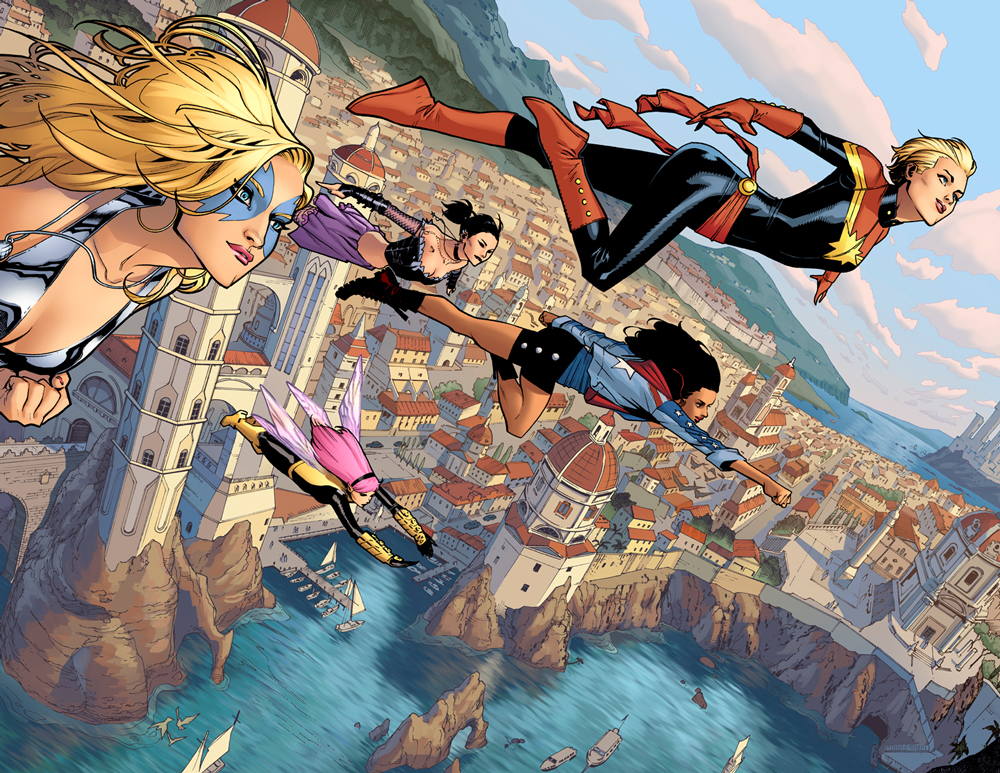I had a gr eat time the other day interviewing Eryk Donavan. Eryk recently enjoyed the release of the Boom! mini-series, Memetic, with his frequent collaborator James Tynion IV. Memetic is a horror story that focuses on a weaponized meme and the distruction that it causes over a 72 hours from the perspective of Aaron, one of the few people immune to the meme’s influence. Eryk talks to me about his method and struggles that a new artist has to experience.
eat time the other day interviewing Eryk Donavan. Eryk recently enjoyed the release of the Boom! mini-series, Memetic, with his frequent collaborator James Tynion IV. Memetic is a horror story that focuses on a weaponized meme and the distruction that it causes over a 72 hours from the perspective of Aaron, one of the few people immune to the meme’s influence. Eryk talks to me about his method and struggles that a new artist has to experience.
Talking Comics: What’s it like working on Memetic with James?
Eryk Donovan: Memetic was James’ inspiration. We’ve done a few things before. We did a 22-page story for a Boom! horror anthology called In the Dark and The House in the Wall with Thrillbent. When the editors at Boom! asked if I would like to work with James again, I was thrilled too; I love James. Once I read the pitch, I was in.
TC: How did you get your start as an artist?
ED: I drew a lot as a kid, as most of us comic artist do. After high  school though, I stopped for a while doing the occasional doodle or sketch. I spent about five years working retail, but with no real focus on a career; I knew all along I wanted to draw. I was never at the professional level though. I had no idea how to get there. I started looking around, ended up at SCAD, which is the Savannah College of Art and Design. I had heard about it through my uncle who had attended there years before, and when I saw they had a program in sequential art, I said, “Hey! That’s comics!” I was very excited to get started.
school though, I stopped for a while doing the occasional doodle or sketch. I spent about five years working retail, but with no real focus on a career; I knew all along I wanted to draw. I was never at the professional level though. I had no idea how to get there. I started looking around, ended up at SCAD, which is the Savannah College of Art and Design. I had heard about it through my uncle who had attended there years before, and when I saw they had a program in sequential art, I said, “Hey! That’s comics!” I was very excited to get started.
I didn’t really grow up reading comics though. I read things like Calvin and Hobbes, Peanuts, and watched anime, which then led me to manga.
TC: I’ve seen that Memetic’s solicitation references Uzamaki. The psychological horror of that book easily compares with this one. Was that at all an influence to your art style for the Memetic?
ED: Not really. James is the fan of Uzamaki. I was always into Ghost in the Shell, Appleseed, and Akira. I also really have a thing for cyberpunk in my work. Honestly, what influenced me the most was Calvin and Hobbes. I loved reading it when I was a kid, even though there were a lot of things I didn’t appreciate until I was older about Waterson’s technique, especially his brush work. The concept of using a brush didn’t hit me until college. Really influenced my aesthetic, and my story-telling style.
TC: What kind of collaboration do you and James have? Full script? Marvel Method?
ED: For me it changes based off of the project. James used full script with panel break-downs, which I enjoy. It gives me a feel for the character. But James is also open-minded. His script isn’t law, it’s more like a guideline. He understands that comics are a marriage of image and text, which is why I think we work so well. Sometimes I add a panel or something if I feel that it’s necessary. I take advantage of the fact that I can tell the story in a different way than how it’s told in words, and change it slightly than just how it’s written in the script.
TC: So the story of Memetic focuses around this meme of “the good-times sloth.” How did that design come about?
ED: James came up with the sloth meme concept. In the script it was just described as a sloth giving a thumbs up. The rest of the design was up to me. I began by researching memes, to make this one feel believable as one. I went through many versions before we decided upon one. Once I had it drawn and inked, Adam Guzowski, our colorist, made it stand out with that spiral.
TC: So, tell  us a little about your method.
us a little about your method.
ED: I draw traditionally, rarely using digital. I like to make physical marks with my tools, my pens and brushes. It mentally gets me into the process. I feel like I’m interacting with my art physically.
TC: I like your ink work. Tell me about these “tools” you mentioned.
ED: On Memetic, I used a lot of brushes when I inked. I also used Nibs. I’ve been using those a lot more when I’m playing with lines. I can be pretty heavy-handed when I use a brush; when I ink, I try to make it very energetic. I still have to be careful though. Mistakes can’t just be removed unlike with digital, but I do like happy accidents.
TC: What have you struggled with as an artist? What challenges do you still run into?
ED: Art is a journey, I’m just trying to find that next hill to climb. I will have to try to render things better, to figure out the best way to capture what is in my mind and put it on paper. There has been a number of challenges. I try to exercise drawing realistically. I had an art tutor when I was twelve. He taught me the basics, and school helped when it came to design. An artist also has to have a firm understanding of anatomy.
A major problem I’ve dealt with these past few years has been the loneliness. It’s a very lonely job. Essentially, you’re sitting in a room all day drawing, which is great, but every job I had before this has involved interaction with others in one way or another. With this job, it simply doesn’t. That’s why going to conventions is really important. Sure, they give you’re a chance to make extra money with your original art and commissions, but without them, there aren’t a lot of chances to be around other creators or other people in general.
TC: What is your con schedule for this year?
ED: I’ll be at Tri-Con in Huntington, Virginia, C2E2, Tidewater in Virginia Beach and Heroes. I love Heroes Con. I do sketches and commissions also. It’s also important for me to bring my original pages. People love to see original work, especially at Heroes.
TC: While doing a little research on you, I noticed you did a web comic that’s a sequel to the Mario Bros. movie. Tell me about that.
ED: (laughing) So right after my wife and I moved to Virginia in 2013, I checked my DeviantArt page, and Steven Applebaum asked me about doing the comic. They were working on an archive for the Super Mario Bros movie and working on a kind of unofficial official sequel to it, which that movie has a huge cult following. They had met with people that had worked on the original and really had done their research. I did three chapters with them, the first being about 26 pages, the second and third around twelve each. We did it about once a week for around a year.
Unfortunately my schedule eventually got in the way, and it wasn’t allowing me to keep it up. I had begun working on Memetic around that time and House in the Wall. I just couldn’t devote any more time to it. I’m very happy with what we did on that comic, and the work I created for it. I still get a lot of compliments about it, which makes me really happy.
TC: So what was your work schedule for Memetic?
ED: Each chapter was about 32 pages, and I had to devote a solid six months to the project, with the exception of doing House in the Wall around the same time. I was happy that I met all of the deadlines, which I guess I wasn’t too worried about. This was my first time to do a major book, and it really taught me how to schedule my time. I was able to work on about an average of one to three pages a day.
TC: Are there any pages that you are really proud of, without giving too much of the story away?
ED: The final page for a lot of reasons. It was emotional in terms of the story, but also due to the experience. Also, it offered me a lot of creative freedom. I’m a fan of the screamers too. I love doing any kind of monstrous action shot.
TC: What are you working on now?
ED: I can’t really talk about it since it hasn’t been announced, but it’s a sci-fi mini-series.
TC: Talk to us about deadlines, was there any pressure to get your work in on time?
ED: I never felt too much pressure. By the time the first issue came out in October, I was finishing up the third. My workload by that point had reached about a ten to fifteen hour day. It was announced months in advanced too, I think at San Diego in July. I know by issue one’s release, I had seen the color proofs for two, but honestly, I had begun to feel a little burned out more than anything.
TC: Do you know if there will be a trade or a hardcover released?
ED: Yes, as far as I know. It’ll probably be later this year, probably around October. As far as what format or whether it’ll be a hardcover- who knows.
TC: Can you tell us anything about your upcoming projects?
ED: Not really. It’s frustrating. A lot of the artist that I admire use social media to show works in progress on stuff they are doing. I really need to do that more often. It is something that I didn’t expect to be an issue when I started out, but I hate that I work for hours and days on something that can’t be seen for months by my friends. It’s a weird feeling.
TC: What are you reading now?
ED: I love Southern Bastards. As someone who was raised in the south, in Florida, there are a lot of things, both good and bad, that I can relate to from the book. It really hits home. I really enjoyed Scalped, Aaron’s other book. I started reading that in school when I was starting out. Guera’s stuff is amazing. I’ve been reading Sex Criminals, Black Science, the Image stuff is great. I also really enjoy Dead Letters.
TC: Could you see yourself doing anything for Marvel or DC?
ED: If it were the right project. The way I draw is pretty raw, so I don’t know how that will tonally fit with most superhero books. Maybe something like Venom or Punisher or Constantine. I’ve never been much of a superhero guy. When I was a kid, I was into the X-Men, like everyone else; I was just never allowed to really read it. My parents kinda kept me away from that. Funny that I mostly draw horror stuff now. I guess their blocking me from it didn’t really work. (laughs)
TC: You say that you mostly draw horror, do you consider yourself a versatile artist?
ED: As an artist you need to be able to draw anything. I’ve had writers ask me, “Tell me what you hate to draw, so that when I’m writing I can avoid that.” That drives me crazy. Maybe there are things I don’t like to draw, but I’m not going to tell my writer that. Like, kids are hard, right? You can’t just draw a smaller adult and expect it to work, the proportions take a lot of practice, but if the script calls for kids, I’m going to figure out the best way to draw a kid. If it makes it a better story, don’t write it out. It’s important to figure out what you enjoy, because if you do this for a living, you’ll be doing it for a while.
TC: You are already a storyteller through your art; would you ever want to try writing as well?
ED: Absolutely. I’ve already written a few things, and would love to tell my own stories. I consider myself a writer as well. As a matter of fact, when I started out, I thought that was what I would be doing. For now, the art is what is working though. I’d love to get to a point where I’m doing both.
TC: Could you see yourself on the other side? Letting someone else illustrate your writing?
ED: Absolutely. I wouldn’t mind at all. Maybe I’d do a web comic or something, although I don’t really have time for that at the moment. That’s the great thing about working now- there are so many ways to get things out there. Granted to be noticed, is really nice as well.
TC: It was great to have a chance to catch up with you Eryk. I really appreciate it.
ED: Thanks for having me, Matt.
Further Exploring:










